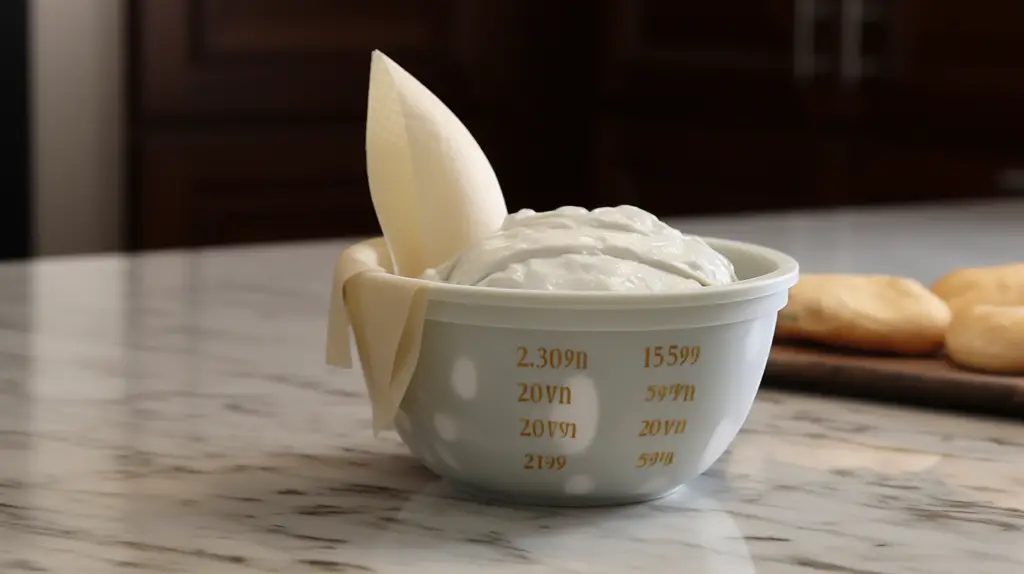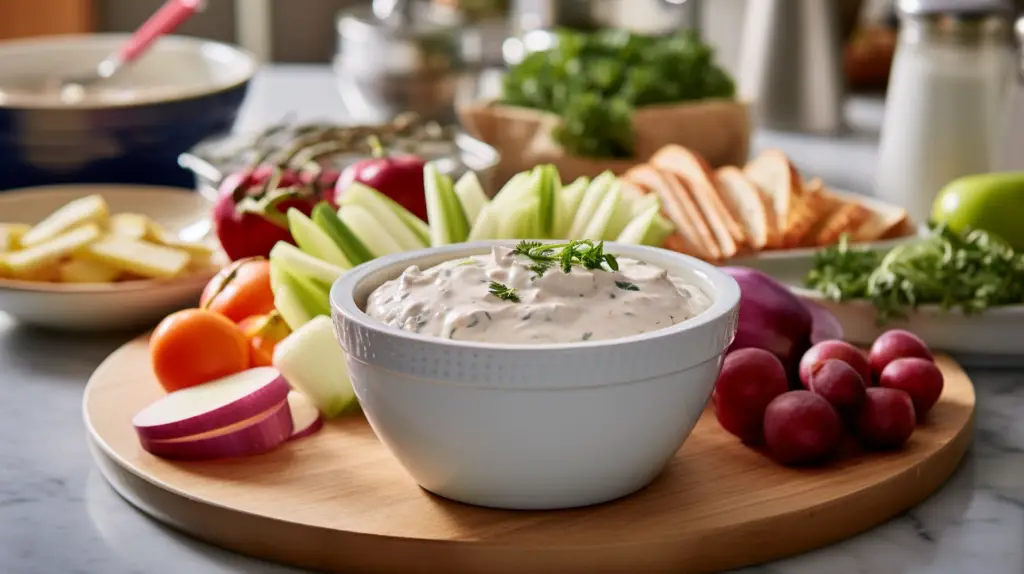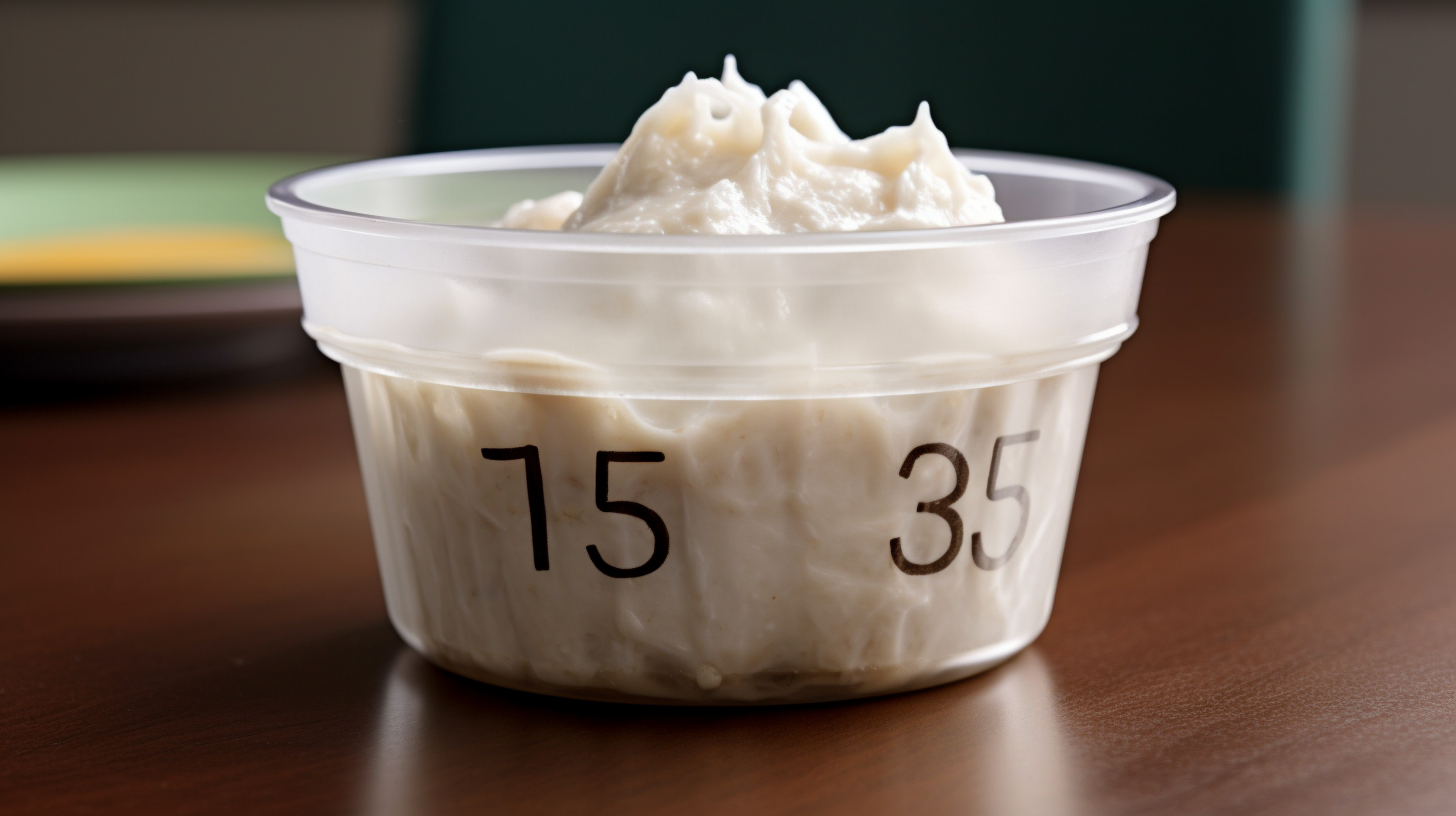Have you ever found yourself craving a creamy and savory dip to pair with your favorite snacks? French onion dip may be the perfect answer to your cravings. Made with sour cream, onions, and various seasonings, this classic dip is a crowd-pleaser at parties or as a simple snack.
However, one question that often arises when enjoying this delicious treat is how long it can last in the fridge. There are many theories about how long French onion dip can stay fresh once opened and stored in the refrigerator. Some argue that it should only be kept for a few days while others claim that it can last for up to two weeks.
The truth is that there isn’t one definitive answer, as several factors can affect the shelf life of this popular dip. In this article, we’ll explore these factors and provide tips on how to properly store French onion dip to ensure its freshness and avoid spoilage.
Key Takeaways
- French onion dip should be stored in an airtight container in the refrigerator at <40°F to prevent bacterial growth and maintain freshness.
- Expiration dates should always be checked, and spoiled dips should be discarded to prevent foodborne illness.
- Preservation techniques like pasteurization, vacuum sealing, freezing, adding preservatives or acidifiers can extend shelf life.
- Leftover dip can be repurposed as a marinade or mixed into other dishes for extra flavor, reducing food waste and adding versatility to meals.
Properly Storing French Onion Dip

Effective storage of French onion dip is crucial to maintain its quality and extend its shelf life, ensuring that it remains safe for consumption. One important factor in proper storage is the refrigeration temperature. It is recommended to store dips in the refrigerator at a temperature below 40°F (4°C). This prevents bacterial growth and preserves the freshness of the dip.
Another important aspect of storing French onion dip is using airtight containers. Oxygen exposure can cause oxidation, which leads to flavor loss and spoilage. Airtight containers prevent air from getting into the container, keeping the dip fresh longer. Additionally, it helps prevent contamination from other foods or bacteria present in the fridge.
It is also essential to keep an eye on any expiration dates listed on packaged dips. While refrigeration and airtight containers can help extend shelf life, all food products have an expiration date. Discard any dips that are past their expiration date or show signs of spoilage such as mold growth, unpleasant odor or taste changes.
Understanding shelf life and expiration dates can help ensure safe food consumption while minimizing waste. By following proper storage techniques such as refrigeration at appropriate temperature levels and using airtight containers, consumers can enjoy fresh-tasting French onion dip for a longer period without compromising on safety concerns regarding foodborne illnesses caused by spoiled foods.
Understanding Shelf Life and Expiration Dates

The duration of a product’s quality and safety can be compared to the lifespan of a living organism, with an expiration date serving as its equivalent to a natural death. Understanding shelf life and expiration dates is crucial in ensuring food safety and preventing foodborne illnesses. French onion dip, like any other perishable food item, has a limited shelf life that depends on various factors such as storage conditions, packaging type, and preservation techniques.
To determine the approximate shelf life of French onion dip, it is essential to check the label for the manufacturer’s recommended storage conditions and expiration date. Most commercially produced dips have an average shelf life of 7-10 days when refrigerated properly at or below 40°F (4°C). However, homemade dips may not last that long due to variations in preparation methods and ingredients used.
Food preservation techniques play a significant role in extending the shelf life of French onion dip. Some common methods include pasteurization, vacuum sealing, freezing, adding preservatives or acidifiers. These techniques help inhibit bacterial growth while preserving flavor and texture. Nevertheless, it is important to note that these methods do not guarantee complete safety; they only slow down spoilage rates.
The importance of food safety standards cannot be overstated when it comes to preserving the freshness of French onion dip or any other perishable food item. It is necessary to follow good hygiene practices such as washing hands before handling foods and using clean utensils during preparation and serving. Additionally, proper storage conditions should always be maintained—refrigerate leftovers promptly at or below 40°F (4°C) within two hours after cooking or purchase.
Factors such as temperature fluctuations, exposure to air/light/moisture/heat sources can affect the freshness of French onion dip even under ideal storage conditions. In the subsequent section about ‘factors that affect dip freshness,’ we will examine how these variables influence spoilage rates over time without compromising food safety standards.
Factors that Affect Dip Freshness
Temperature fluctuations, exposure to air/light/moisture/heat sources, and microbial activity are all factors that contribute to the degradation of dip freshness. The storage temperature plays a crucial role in maintaining the quality of French onion dip. Ideally, it should be stored at a temperature range between 35°F to 40°F. Keeping it at a higher temperature can cause bacterial growth, while storing it below 35°F can result in textural changes such as hardening or curdling.
The type of container used for storing the dip also affects its freshness. Airtight containers help to prevent exposure to air and moisture, thereby slowing down the rate of spoilage. Glass jars or plastic containers with tight-fitting lids are good choices for storing French onion dip. On the other hand, metal cans may not provide an adequate barrier against light and oxygen that can cause discoloration and flavor changes over time.
Apart from temperature and container type, microbial activity is another crucial factor affecting French onion dip’s freshness. This is because dips contain ingredients like sour cream or mayonnaise that are prone to bacterial growth when exposed to favorable conditions such as warm temperatures and humidity levels. As such, it is essential always to check the expiration date before consuming any dip.
Proper storage techniques play a significant role in maintaining French onion dip’s freshness. Factors like storage temperature and container type should be considered when trying to preserve its flavor and texture for longer periods. However, even with proper storage techniques in place, signs of spoilage can still occur over time; hence it is essential always to watch out for these signs when consuming any food product beyond its expiration date without fail.
Signs of Spoilage to Watch Out For
Bacterial growth and chemical reactions can cause several signs of spoilage to manifest in French onion dip, making it important to be able to recognize these indicators. One of the most common causes of spoilage is improper storage, as dips that are left out for too long or stored at incorrect temperatures can quickly become contaminated. Additionally, exposure to air and moisture can also lead to spoilage. In order to prevent this from happening, it is crucial to store dips in airtight containers and refrigerate them promptly after use.
To determine if your French onion dip has spoiled, there are several signs you should watch out for. One such indication is a sour smell or taste, which may indicate bacterial growth. Another sign is mold growth on the surface of the dip or on the sides of the container. A change in color or texture could also signify that your dip has gone bad. If any of these signs are present, it is best to dispose of the dip immediately.
While it’s never ideal for your French onion dip to go bad, there are alternative uses for spoiled dips that can help reduce waste. For example, you could use spoiled dip as a marinade for meat or vegetables before grilling them. Alternatively, you could mix small amounts into other dishes like casseroles or mashed potatoes to add extra flavor.
Recognizing signs of spoilage and taking proper precautions when storing French onion dip can help prolong its shelf life and prevent contamination. In the next section, we will provide tips on how to keep your dip fresh for longer periods of time without compromising its quality or taste.
Tips for Prolonging French Onion Dip’s Shelf Life
One effective way to extend the shelf life of French onion dip is by employing proper storage techniques. This can be achieved by placing the dip in a container that is airtight, such as a vacuum-sealed bag. This will prevent air and moisture from entering, which can lead to spoilage.
In addition, it is recommended to store the dip towards the back of the refrigerator where temperatures are cooler. Another option for prolonging French onion dip’s shelf life is freezing. Freezing the dip in small portions will allow for easy thawing when needed. However, it is important to note that freezing may alter the texture and flavor of the dip slightly. To combat this, consider adding additional spices or herbs to enhance its flavor after thawing.
In addition to proper storage and freezing options, there are other ways to enhance and repurpose leftover French onion dip. For example, it can be used as a flavorful topping for baked potatoes or spread onto sandwiches in place of mayo or mustard. It can also be mixed into scrambled eggs or used as a base for a creamy salad dressing.
Taking care when storing French onion dip and utilizing freezing options can help extend its shelf life. Furthermore, with some creativity and experimentation in repurposing leftovers, one can make delicious use of any remaining dip without letting it go to waste.
Creative Uses for Leftover Dip
Utilizing leftover French onion dip can be a creative and flavorful way to enhance various dishes. Repurposing leftovers is an excellent way to reduce the amount of food waste while also adding delicious flavors to your meals. There are numerous ways to incorporate leftover French onion dip into your cooking, which will elevate the taste of your dishes.
One creative use for leftover French onion dip is as a sauce for roasted vegetables or grilled meats. The creamy and savory flavor of the dip pairs well with roasted broccoli, cauliflower, or carrots. Additionally, it can add depth of flavor when brushed onto chicken or steak before grilling or roasting. This unique dip pairing adds an extra dimension of flavor to your meal and makes it more enjoyable.
Another great way to repurpose leftover French onion dip is by using it as a spread on sandwiches or burgers. The tangy flavor of the dip goes well with deli meats such as turkey, ham, and roast beef. It also pairs nicely with grilled burgers, adding an extra layer of richness that brings out the meat’s flavors.
Lastly, you can mix leftover French onion dip into mashed potatoes for a flavorful twist on classic comfort food. The addition of the rich and savory dip enhances the natural creaminess of mashed potatoes while providing a unique burst of flavors that will excite your taste buds.
Repurposing leftovers is an excellent way to reduce food waste while exploring new culinary possibilities in your kitchen. Leftover French onion dip presents numerous opportunities for creative uses beyond just being eaten with chips or vegetables. Incorporating this versatile condiment into different recipes provides unique pairings that add depth and complexity to everyday dishes.
Frequently Asked Questions
Can French onion dip be frozen?
French onion dip can be frozen, but it is important to take certain precautions to ensure that the quality of the dip is not compromised.
Freezing dips is a great way to prolong their shelf life and preserve their flavor for later use. However, it is crucial to properly thaw frozen dip before consuming it.
To thaw frozen dip, place it in the refrigerator overnight or allow it to sit at room temperature for several hours until completely defrosted. It is not recommended to thaw dips in the microwave as this can cause uneven heating and alter the texture of the dip.
Additionally, once a dip has been thawed, it should be consumed within 2-3 days and should not be refrozen.
By following these guidelines, individuals can safely freeze their favorite dips without sacrificing taste or quality.
What should I do if I accidentally left my dip out of the fridge overnight?
Refrigeration tips are crucial when it comes to food safety, especially with perishable items such as dips and sauces. Leaving a dip out of the fridge overnight can pose a risk for bacterial growth, which could lead to potential foodborne illnesses. In this case, it is advisable to discard the dip as a precautionary measure.
However, if the dip has been left out for less than two hours, it may still be safe to consume. Shelf life considerations also come into play when storing dips in the fridge. Typically, homemade dips should not be kept in the refrigerator for more than 3-4 days while store-bought options may last up to 7-10 days after opening.
To extend their shelf life, make sure that they are stored properly in an air-tight container and kept at a consistent temperature of 40°F or below. It is important to note that even if the dip appears and smells fine after its expiration date or being left out of refrigeration for too long, it is best not to take any chances and discard it instead.
Can I still eat French onion dip after the expiration date has passed?
Consuming expired dips can be risky as it may lead to foodborne illnesses. The shelf life of dips in the fridge varies depending on the ingredients used, storage conditions, and other factors.
It is generally recommended to consume dips before their expiration date to ensure food safety. Eating expired dips may result in stomach cramps, diarrhea, nausea, vomiting, and fever due to bacterial growth.
Therefore, it is essential to follow proper storage guidelines for dips such as keeping them refrigerated at all times and discarding any leftovers after a certain period.
In conclusion, it is not advisable to consume french onion dip or any other type of dip beyond its expiry date as it poses a potential health risk.
Is it safe to eat French onion dip if it has separated?
As the old adage goes, ‘when in doubt, throw it out.’When it comes to separated French onion dip, the same principle applies. Separation is a sign that the dip has undergone some changes and may no longer be safe for consumption.
However, if you’re determined to salvage your dip, there are ways to fix it. One method involves stirring the dip vigorously until its consistency becomes smooth again. Another option is to add a small amount of sour cream or mayonnaise and blend until fully incorporated.
Despite these fixes, consuming separated dip still poses health risks. If fixing is not an option, alternatives include making a fresh batch or opting for pre-packaged dips with a longer shelf life.
It’s important to note that these options should only be considered if the current question arises without considering how long does French onion dip last in the fridge as expired dips can cause food poisoning or other health complications even when they haven’t separated yet.
How can I tell if my French onion dip has gone bad?
To determine if French onion dip has gone bad, there are several common signs of spoilage to look out for. One of the most noticeable is the development of an off smell or taste, which can indicate bacterial growth.
The texture may also become slimy or gritty, and mold may begin to form on the surface. Additionally, separation or discoloration can be a sign that the ingredients have begun to break down.
To prevent French onion dip from spoiling, it is important to store it in an airtight container in the refrigerator and consume it within a reasonable time frame after opening. Proper hygiene practices should also be followed when preparing and serving dip, such as washing hands before handling food and using clean utensils to avoid introducing bacteria into the mixture.
Conclusion
French onion dip is a popular party food that can be served with vegetables, chips, or crackers. Proper storage is essential to maintain the freshness of this dip. It should be kept in an airtight container and stored in the refrigerator for up to five days. Factors such as temperature fluctuations and exposure to air can affect its lifespan.
Understanding the shelf life of French onion dip is crucial to avoid consuming spoiled food. The expiration date on the packaging indicates when it should no longer be consumed, but several other factors can impact its freshness, including bacterial growth and oxidation. Consumers must also look for signs of spoilage, such as discoloration, off-odors, or mold growth before consuming leftover dip.
According to a study by the Natural Resources Defense Council (NRDC), 40% of all food produced in the United States goes uneaten and ends up in landfills. This statistic highlights how important it is to minimize food waste by properly storing perishable items like French onion dip and using creative ways to repurpose leftover food.
By reducing our waste footprint and being mindful of our consumption habits, we can make a positive impact on both our health and the environment.

